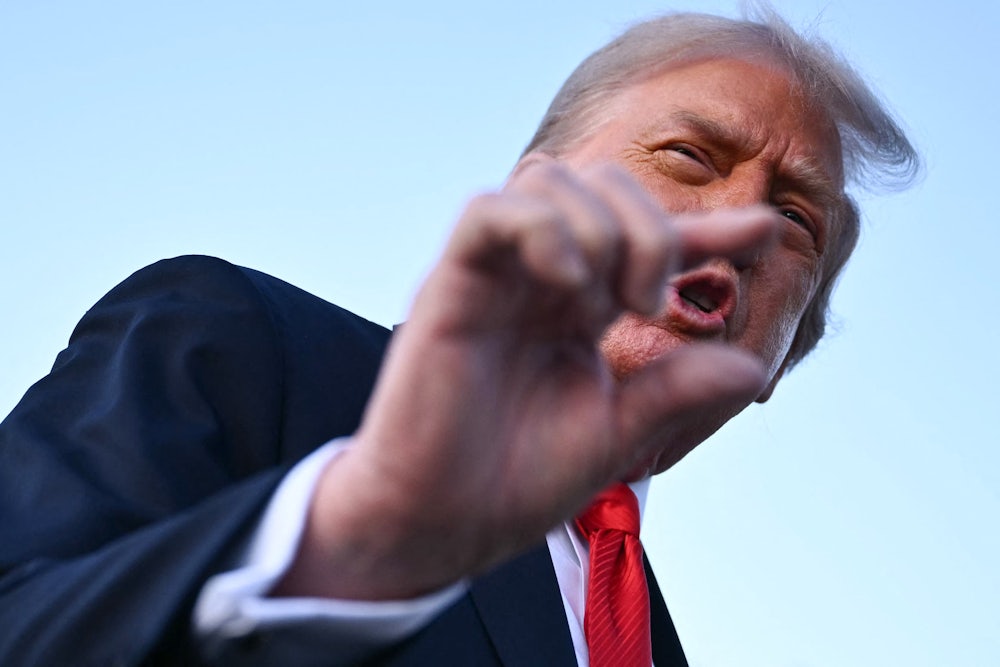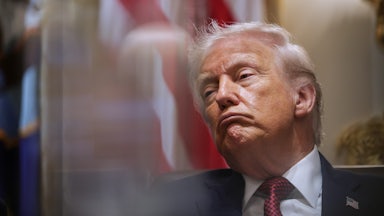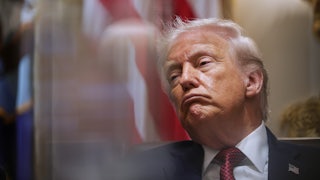The headline news from the jobs numbers Friday was that unemployment rose to nearly a four-year high in August—that is, higher than it was during the majority of President Joe Biden’s presidency. But that isn’t really new; unemployment has been higher than during most of Biden’s presidency ever since Trump took office. What’s newsworthy is not that the unemployment rate is 4.3 percent (that’s not especially high) but rather that it isn’t significantly higher.
The reason unemployment ought to be higher is that the economy created only 22,000 jobs in August, after creating only 79,000 in July. The 79,000 figure represents a slight upward revision from an initial July estimate of 73,000 that so enraged Trump that he fired BLS Commissioner Erika McEntarfer and nominated to replace her a MAGA sociopath who, when Senator John McCain died, tweeted, “I like a senator who doesn’t die” (mimicking Trump’s repellant 2015 taunt about McCain, “I like people who weren’t captured”).
Gaining 6,000 July jobs was a victory of sorts for Trump, but any vindication he might claim was undone by a downward revision of the June job creation number, initially reported as 147,000, into a job-loss number of 13,000. In other words, whatever difficulty BLS is experiencing in reporting accurate jobs numbers (shrinking budgets and a hiring freeze don’t help) would appear to result mainly in job creation estimates that are too high, not too low.
Still, overstated job creation is not why the unemployment rate should be higher. It should be higher because there ought to be more workers.
Why doesn’t America have enough workers? Mostly because Americans don’t procreate like we used to (the fertility rate peaked in 1957 and has mostly declined since). Even in raw numbers, births have been down since 2007, possibly because we’re less frisky. Paul Ehrlich, author of the 1968 bestseller The Population Bomb (he’s now 92!) is no doubt gratified that we’re straining environmental resources less than he once feared, and in further good news, smaller families reduce poverty.
But lower birth rates, combined with a rapidly aging population (there are about 1.5 million retirements per year) mean fewer workers, and the United States can’t remain the world’s biggest economy with a shrinking labor market. We therefore import labor, both legally and illegally. Or rather, we did. When Trump reentered the White House this past January, immigrants represented 20 percent of the U.S. workforce, according to the Pew Research Center. Now they represent 19 percent. In five short months the number of foreign-born workers has dropped by an astounding 750,000.
To put this in historical context, from about 1970 until this past January the foreign-born population of the United States never shrank. In January it stood at an all-time high of 15.8 percent—higher even than during the Gilded Age, when the foreign-born proportion peaked (in 1890) at 14.8 percent. Then Trump returned to the White House. During his first five months in office, the foreign-born population receded from 15.8 percent to 15.4 percent. That’s more than a million people gone. There’s every reason to believe the foreign-born represent an even smaller percentage of the population today than in June.
According to Pew, the disappearance of foreign-born workers is not entirely attributable to Trump’s policies. In June 2024, Biden cracked down on asylum for people who crossed the southern border illegally, drastically reducing monthly border arrests (already well below a 2023 peak of about 250,000) to about 50,000. As a result, Trump’s claim on entering office that border crossings were a national emergency that required deployment of armed troops was, as is so often the case, false. Border crossings did continue to fall under Trump, but any emergency, if there was one, had long since passed.
Still, through Trump’s deliberately cruel national crackdown on undocumented aliens (“I love the smell of deportations in the morning”), the Donald did increase quite meaningfully both detentions and deportations of foreign-born workers. Deportations were estimated in late August to number about 350,000 since Trump took office, putting the administration on track to beat the previous annual record (under President Barack Obama) of 400,000 deportations. Stephen Miller is aiming to remove one million immigrants during Trump’s first year, which probably won’t happen, but between Biden and Trump the foreign-born workforce is down by three-quarters of one million.
That would be more noticeable if economic growth weren’t down too. In a speech last month, Jerome Powell observed that gross domestic product growth during the first two quarters of 2025 was about half its rate during the same period in 2024. Meanwhile, Powell said, the “labor supply has softened in line with demand.… While the labor market appears to be in balance, it is a curious kind of balance that results from a marked slowing in both the supply of and demand for workers.”
Translation: Trump is destroying economic growth with tariffs at about the same rate that he’s chasing foreign-born workers out of the country. The reason unemployment isn’t getting bigger is that the economy is getting smaller. Remember that movie The Incredible Shrinking Man? A 1950s dad shrinks first to the size of a child, then to the size of doll (look out for the family cat!), and finally to the size of an insect. Welcome to the Incredible Shrinking Economy.
The Trump administration claims, based on BLS data, that the number of native-born workers is growing while the number of foreign-born workers shrinks. But there’s a rough consensus that BLS’s estimate of foreign-born workers who’ve left since January (1.9 million!) is way too high and that its estimate of native-born workers who’ve entered the workforce since January (3.3 million!) is a statistical mirage. I won’t bore you with why. What is much more likely is that since January the labor market has lost foreign-born workers (again, about 750,000; some go as high as one million) but not gained native-born workers to any significant degree. Hence a smaller labor market and low unemployment.
In theory, this ought to be good news for native-born workers. But as Stuart Anderson noted Sunday in Forbes, there’s absolutely no evidence that the departure of foreign-born workers is doing anybody any good, not even the shrunken workforce that remains. The law of supply and demand says that native-born workers ought to be earning more, but they aren’t. According to an analysis of BLS data by the nonprofit Economic Policy Institute, increases in nominal average hourly earnings have continued a downward slide that began in 2022.
The workforce is more native-born today than it was when Trump entered office. But the same xenophobia that motivates expelling foreign-born workers also motivates raising tariffs on foreign-made products. Trump thinks that makes the economy stronger, but it only makes the economy smaller, and that’s what’s happening. Even if unemployment remains stable for a while, eventually it will catch up as the economic slowdown starts to outpace deportations. Then the economy will be both smaller and weaker, and we’ll enter a recession. I hope there aren’t any cats.










